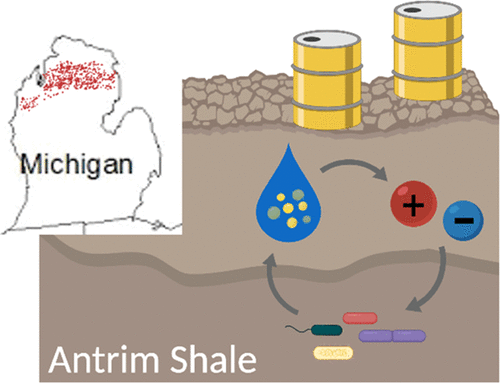
Biogeochemistry of the Antrim Shale Natural Gas Reservoir
Abstract
The Antrim Shale, located in the Michigan Basin, United States (U.S.), is a major U.S. shale play having produced over 2.5 Trillion Cubic Feet (Tcf) of unconventional shale natural gas as of 2010. The shallow nature of this formation sets it apart from other, more characterized unconventional shale gas plays. The depth of gas production of the Antrim ranges from approximately 150 to 600 m and it is typically vertically drilled, contrary to deeper, horizontally drilled shales. A thorough understanding of the biogeochemistry and microbiology of this complex system will be advantageous for improving well performance, produced water management, and potential biocidal treatment as microbial community composition can vary substantially even among closely spaced wells. In this study, we analyzed produced water collected from nine different wells in the Antrim Shale by investigating the geochemical and microbial community composition of the produced water to gain greater insight into the overall biogeochemistry of this unique shale system. The majority of the wells from this study had high total dissolved solids (TDS) primarily composed of chloride and sodium, averaging 86 804 mg/L with a maximum 116 223 mg/L; however, three of the wells sampled along the northern margin of the basin exhibited significantly lower TDS ranging from 4932 to 6496 mg/L. Our microbial community analysis revealed relatively low abundance within our samples and high variability of the microbial community among the sampled wells. The majority of bacterial sequences were identified within Proteobacteria, Firmicutes, and Actinobacteria phyla and metagenomic sequencing revealed the low presence of Methanobacteriaceae within each sample. We also investigated potential microbial community drivers and found that TDS, sodium, chloride, iodide, bromide, ammonium, potassium, and strontium were significantly correlated with the observed microbial community. The varying geochemical conditions between wells demonstrate different subsurface environmental niches, potentially driving the heterogeneous microbial communities we observed from well to well. This analysis suggests an important relationship between both well location and geochemistry and the observed microbial community that can persist in the reservoir. Continued studies of the Antrim Shale will improve our understanding of the complex interdependencies of this ecosystem.
Link
https://pubs.acs.org/doi/abs/10.1021/acsearthspacechem.1c00087